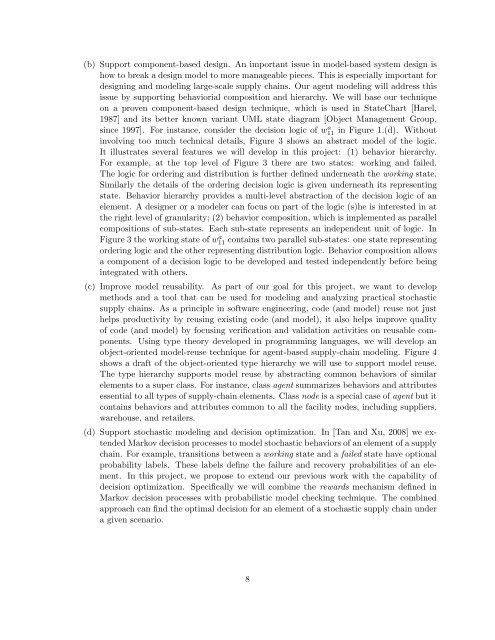SimRisk: An Integrated Open-Source Tool for Agent-Based ...
SimRisk: An Integrated Open-Source Tool for Agent-Based ...
SimRisk: An Integrated Open-Source Tool for Agent-Based ...
Create successful ePaper yourself
Turn your PDF publications into a flip-book with our unique Google optimized e-Paper software.
(b) Support component-based design. <strong>An</strong> important issue in model-based system design is<br />
how to break a design model to more manageable pieces. This is especially important <strong>for</strong><br />
designing and modeling large-scale supply chains. Our agent modeling will address this<br />
issue by supporting behaviorial composition and hierarchy. We will base our technique<br />
on a proven component-based design technique, which is used in StateChart [Harel,<br />
1987] and its better known variant UML state diagram [Object Management Group,<br />
since 1997]. For instance, consider the decision logic of w11 a in Figure 1.(d). Without<br />
involving too much technical details, Figure 3 shows an abstract model of the logic.<br />
It illustrates several features we will develop in this project: (1) behavior hierarchy.<br />
For example, at the top level of Figure 3 there are two states: working and failed.<br />
The logic <strong>for</strong> ordering and distribution is further defined underneath the working state.<br />
Similarly the details of the ordering decision logic is given underneath its representing<br />
state. Behavior hierarchy provides a multi-level abstraction of the decision logic of an<br />
element. A designer or a modeler can focus on part of the logic (s)he is interested in at<br />
the right level of granularity; (2) behavior composition, which is implemented as parallel<br />
compositions of sub-states. Each sub-state represents an independent unit of logic. In<br />
Figure 3 the working state of w11 a contains two parallel sub-states: one state representing<br />
ordering logic and the other representing distribution logic. Behavior composition allows<br />
a component of a decision logic to be developed and tested independently be<strong>for</strong>e being<br />
integrated with others.<br />
(c) Improve model reusability. As part of our goal <strong>for</strong> this project, we want to develop<br />
methods and a tool that can be used <strong>for</strong> modeling and analyzing practical stochastic<br />
supply chains. As a principle in software engineering, code (and model) reuse not just<br />
helps productivity by reusing existing code (and model), it also helps improve quality<br />
of code (and model) by focusing verification and validation activities on reusable components.<br />
Using type theory developed in programming languages, we will develop an<br />
object-oriented model-reuse technique <strong>for</strong> agent-based supply-chain modeling. Figure 4<br />
shows a draft of the object-oriented type hierarchy we will use to support model reuse.<br />
The type hierarchy supports model reuse by abstracting common behaviors of similar<br />
elements to a super class. For instance, class agent summarizes behaviors and attributes<br />
essential to all types of supply-chain elements. Class node is a special case of agent but it<br />
contains behaviors and attributes common to all the facility nodes, including suppliers,<br />
warehouse, and retailers.<br />
(d) Support stochastic modeling and decision optimization. In [Tan and Xu, 2008] we extended<br />
Markov decision processes to model stochastic behaviors of an element of a supply<br />
chain. For example, transitions between a working state and a failed state have optional<br />
probability labels. These labels define the failure and recovery probabilities of an element.<br />
In this project, we propose to extend our previous work with the capability of<br />
decision optimization. Specifically we will combine the rewards mechanism defined in<br />
Markov decision processes with probabilistic model checking technique. The combined<br />
approach can find the optimal decision <strong>for</strong> an element of a stochastic supply chain under<br />
a given scenario.<br />
8




